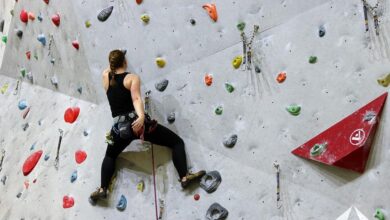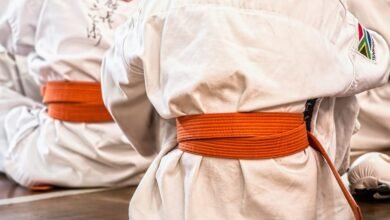Unlock Peak Performance: The Ultimate Guide to Sport-Specific Training for Athletes

Achieving peak performance is an athlete’s ultimate goal, whether in recreational or professional settings. Sport-specific training is a pivotal component of reaching that zenith, as it hones the skills and physical attributes needed for a particular sport. This comprehensive guide will explore the nuances of sport-specific training to help athletes unlock their full potential.
Introduction
Sport-specific training involves tailoring fitness regimens to meet the unique demands of a particular sport. Unlike general fitness training, which focuses on overall health and well-being, sport-specific training zeroes in on optimizing performance, reducing injury risk, and ensuring athletes are in the best possible shape for their sport.
Why Sport-Specific Training?
- Enhanced Performance: By focusing on the unique physical and metabolic needs of the sport, athletes can enhance their sport-specific skills and improve overall performance.
- Injury Prevention: Properly targeting muscles and movements that are frequently used in the sport helps prevent overuse injuries.
- Efficiency: Sport-specific training ensures that the time spent exercising is aligned with performance goals, maximizing training efficiency.
- Mental Preparation: Athletes train not just their bodies but their minds by simulating game-like scenarios, improving mental resilience and decision-making skills.
Analysis of Sport Demands
Before diving into the specifics of training programs, it is crucial to identify the key elements that define the physical and technical demands of a sport. Analyzing the sport helps to tailor training effectively. These elements include:
- Energy System Contributions: Understanding the predominant energy system (aerobic, anaerobic, or ATP-PC) helps design appropriate conditioning programs.
- Movement Patterns: Identifying common movements such as jumping, sprinting, cutting, or throwing can direct the focus of training.
- Skill Requirements: Fine-tuning sport-specific skills like dribbling, passing, or shooting is essential.
- Physiological Characteristics: Assessing the strength, power, endurance, agility, flexibility, and coordination required by the sport.
Designing a Sport-Specific Training Program
Creating an effective sport-specific training program involves several steps:
1. Assessment and Benchmarking
Start with an assessment of the athlete’s current fitness level, skill proficiency, and performance metrics. This provides a baseline to measure progress and identify areas of improvement. Common assessment methods include:
- Physical Assessments: Tests for strength, endurance, speed, agility, and flexibility.
- Skill Assessments: Sport-specific drills to evaluate current skill levels.
- Performance Metrics: Game or match statistics, if applicable.
2. Goal Setting
Setting clear, measurable, and achievable goals is fundamental. These goals should align with the athlete’s aspirations, whether it’s improving a particular skill, increasing strength, or reducing injury risk. Goals should follow the SMART criteria: Specific, Measurable, Achievable, Relevant, and Time-bound.
3. Periodization
Periodization involves breaking down the training program into phases, each with specific goals focusing on different aspects of fitness. Common periodization models include:
- Macrocycle: The overall training period, often a year or a season.
- Mesocycle: A phase within the macrocycle, lasting several weeks to months, focusing on a specific element like strength or endurance.
- Microcycle: Shorter phases within a mesocycle, typically a week, outlining the daily and weekly training details.
4. Strength and Conditioning
Strength and conditioning form the backbone of sport-specific training. Different sports require varying emphases on these components:
- Strength Training: Essential for sports requiring power, speed, and explosiveness. Incorporates exercises like squats, deadlifts, bench presses, and sport-specific adaptations (e.g., rotational exercises for baseball).
- Conditioning: Focuses on cardiovascular fitness, agility, and sport-specific endurance. Includes aerobic conditioning, high-intensity interval training (HIIT), and plyometrics.
5. Technical and Tactical Training
This aspect focuses on improving the specific skills and strategies required for the sport. It involves:
- Skill Drills: Repetitive practice of key skills like dribbling, serving, or shooting.
- Game Simulations: Practice sessions mimicking actual game scenarios to improve decision-making and tactical awareness.
- Video Analysis: Reviewing performance footage to identify strengths and areas for improvement.
6. Recovery and Nutrition
Optimizing recovery and nutrition is crucial for maintaining performance and preventing injuries:
- Recovery Protocols: Incorporate adequate rest, active recovery sessions, massage, and techniques like foam rolling and stretching.
- Nutrition: Tailor diets to meet the energy demands of the sport, ensuring a balance of macronutrients (carbohydrates, proteins, fats) and micronutrients (vitamins, minerals). Hydration strategies are also vital.
7. Mental Conditioning
Mental toughness can set elite athletes apart. Mental conditioning strategies include:
- Visualization: Imagining successful performance scenarios to build confidence.
- Mindfulness and Stress Management: Techniques like meditation or deep breathing to maintain mental focus.
- Goal-Oriented Mindset: Encouraging setting and achieving small, incremental objectives to build momentum.
Sport-Specific Examples
1. Soccer
- Physical Demands: High aerobic capacity, explosive speed, strong lower body strength.
- Training Focus: Endurance running (intervals and long-distance), agility drills (cone exercises), strength training (leg press, lunges), and skill work (dribbling, passing, shooting).
2. Basketball
- Physical Demands: Power, agility, aerobic capacity, and hand-eye coordination.
- Training Focus: Plyometrics (jumping drills), strength training (squats, bench press), conditioning (HIIT), and skill drills (shooting, dribbling, defense).
3. Swimming
- Physical Demands: Aerobic capacity, strength, flexibility, and technique.
- Training Focus: Aerobic conditioning (long swims), strength training (pull-ups, planks), technique improvement (stroke analysis), and flexibility training (dynamic stretching, yoga).
4. Tennis
- Physical Demands: Agility, anaerobic capacity, flexibility, and hand-eye coordination.
- Training Focus: Agility drills (ladder exercises), anaerobic conditioning (short sprints), strength training (core work, leg strength), and technique drills (serve, volley, groundstrokes).
Implementing and Adjusting the Program
A well-rounded sport-specific training program should be adaptable. Athletes and coaches need to monitor progress and make adjustments based on performance feedback, injury status, and changing goals. Regular re-assessments help in fine-tuning the program to ensure continuous development.
Monitoring Techniques
- Performance Tracking: Using tools like performance apps or wearable technology to track key metrics.
- Coach Feedback: Regular feedback from coaches to provide insights and adjustments.
- Self-Assessment: Encouraging athletes to self-reflect on their progress and areas needing improvement.
Adjustments and Adaptations
Adjustments might include shifting the focus within the periodization cycle, modifying intensity and volume based on recovery and performance, and addressing any emerging weaknesses or imbalances.
Conclusion
Sport-specific training is a dynamic and focused approach to achieving peak athletic performance. By precisely tailoring the training to meet the demands of the sport, athletes can enhance their physical and technical abilities, prevent injuries, and maximize their potential. This ultimate guide serves as a comprehensive roadmap, providing the framework and insights necessary to unlock peak performance through sport-specific training.
For athletes and coaches committed to excellence, embracing the principles of sport-specific training can be the difference between good and truly exceptional performance.




